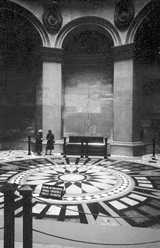 |
||||||||
| Chapel interior showing marble floor, Hamilton Palace Mausoleum, Hamilton, South Lanarkshire | ||||||||
 © RCAHMS |
A monument to the immortal self-belief of Alexander, 10th Duke of Hamilton (1767-1852), Hamilton Palace Mausoleum is a remarkable, Roman-style domed structure which stands to an overall height of about 36.5m. Begun after 1848 to the designs of the architect David Bryce (1803-76), the building was evidently not fully completed until about 1857. When, in 1852, the 10th Duke died he was, in accordance with his long-planned intentions, embalmed, placed in an Egyptian sarcophagus and temporarily laid in the unfinished mausoleum chapel. The sumptuous quality of the exterior continues inside the chapel where the marble mosaic floor, with its magnificent centrepiece seen here, together with the black marble pedestal for a sarcophagus, reflects the 10th Duke’s passion for a material which he used extensively throughout the nearby palace. The eight-sided chapel with its four alcoves, two of which can be made out in this view, rises to a coffered (sunk-panelled) dome through a tribune or gallery stage which contains eight empty niches. The original outer doors, now stored inside the mausoleum, are of cast bronze, made by James Milne of Edinburgh, and evidently modelled on the design of the Ghiberti doors at the Baptistry of Florence. |
|||||||
|
The chapel possesses remarkable acoustic qualities. Complex and noisy reverberations, including an echo of up to 15 seconds' duration, possibly as long as any building in Scotland, has made it impossible for the chapel to fulfil its intended use as a place of worship. |
||||||||
|
|
|
|
|
|
|
|
|
|
 David
Bryce drawing, 1850 David
Bryce drawing, 1850 |
 View
in c.1857 View
in c.1857 |
|||||||
|
|
|
|
|
|
|
|
|
|